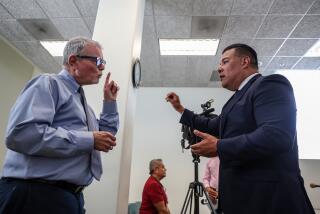Eyes, Voice Insured : Lloyd’s--Its Policy Gets Wider Risks
- Share via
LONDON — Three hundred years ago this month, an Englishman named Edward Bransby offered a $2 reward for word about his stolen watches.
Suitable information, he declared, should be presented at a London coffeehouse run by Edward Lloyd.
While the deal was hardly big money, it marked the beginnings of one of the most famous, unusual and successful business ventures ever launched: Lloyd’s of London.
Barely 400 yards from the site of the original coffeehouse, Lloyd’s today operates from an avant-garde, steel-and-glass high-rise, its 400 or so insurance underwriters willing to cover just about any risk conceivable, from the routine to the barely imaginable.
“Lloyd’s size and flexibility make it the insurer of last resort,” noted Philip Olsen, an insurance industry analyst for Kitcat & Aitkin, a London stockbroker. “It’s willing to accept risks that others won’t touch.”
Although Lloyd’s is one of the world’s biggest players in the field of marine, aviation and motor insurance, it is the breadth of its coverage that has made it legendary. Whether it is the world’s largest cigar, the robot R2D2 from the “Star Wars” trilogy of films or a seagoing bathtub, someone at Lloyd’s has agreed to cover it against loss or damage.
For movie stars and singers, insuring all or bits of themselves with Lloyd’s has become as much a status symbol as insurance protection. Elizabeth Taylor’s eyes, Bruce Springsteen’s voice and Marlene Dietrich’s legs have all at one time or another been insured with Lloyd’s.
In 1982, when National Football League players went on strike, it was a Lloyd’s policy that covered club owners against the strike’s impact.
To those who work in Lloyd’s sprawling underwriting room, known simply as The Room, the unusual has long since become routine.
Even Dinosaur Bones
“I guess it was the dinosaur bones,” said Lloyd’s underwriter Timothy Jonas after some thought about the most unusual risk he has underwritten. “They were transported in five cases from East Germany to Japan, and my main concern was a box getting lost and my dinosaur arriving minus its neck,” he recalled.
The bones, neck and all, and insured for $1 million, arrived safely.
In a world where the type and size of insurance risks have grown exponentially in recent years, so has Lloyd’s itself. Its premium capacity, the yardstick used to measure the amount of insurance that can be safely underwritten, has quadrupled since 1980 to $20 billion this year, making it second in size only to the U.S. life insurance giant, Prudential.
In 1984, the last year for which results have been published, Lloyd’s registered profits of $490 million, the highest ever recorded.
This growth has come despite a series of devastating scandals that have cost Lloyd’s millions of dollars, tainted its esteemed name and, at one point, seemed to threaten the very nature of the institution.
“While we were going through this trauma, business was booming down in the marketplace,” Lloyd’s Chairman Murray Lawrence said in a recent interview. “People have been screaming for Lloyd’s coverage.”
There’s little mystery why the controversy failed to dampen business. Through it all, Lloyd’s stuck to the cardinal rule: No policyholder with a legitimate claim went unpaid.
That rule has long been at the heart of Lloyd’s success. In the aftermath of the 1906 earthquake and fire that destroyed much of San Francisco, Lloyd’s brushed aside the fact that many of its policyholders were insured only against fire damage, while others had only earthquake coverage. Instead, the leading underwriter of the coverage dispatched a 13-word cable to his agent on the spot: “Pay all our policyholders in full, irrespective of the terms of their policies.”
Another Lloyd’s underwriter, agreeing to insure the Titanic against total loss after learning that the great liner had been holed by an iceberg, instructed the broker to come around in the morning for written confirmation of the coverage. The commitment was dutifully confirmed the following morning--with the Titanic already at the bottom of the Atlantic.
A Market, Not a Firm
While reliability helped to make its reputation, the key to Lloyd’s success is its unusual organization. For behind all the corporate trappings, Lloyd’s is not a company at all. It is a marketplace, much as Edward Lloyd’s coffeehouse became one for shipowners, insurance brokers and underwriters in the 1690s.
Just as Lloyd provided pen, paper and amenable surroundings for the underwriters of his day, so Lloyd’s today provides the necessities and establishes basic rules but has no control over an underwriter’s day-to-day business.
In an era when the corporate world enjoys growing security, Lloyd’s underwriters remain entrepreneurs, ready to enjoy healthy profits, yet personally liable down to their last shoelace for the losses that they may incur.
They group together into syndicates both large and small, enabling them to underwrite risks greater than any one of them alone can afford to take, and often nurture speciality high-risk sidelines such as racehorses or deep-sea towing.
“Individually, we are underwriters; collectively, we are Lloyd’s,” goes the time-honored saying.
A maverick streak running through the best-known Lloyd’s underwriters defies the stereotypical gray image of the insurance business and helps explain why Lloyd’s is willing to consider special risks that other insurers turn away. And sometimes, yesterday’s special risks become today’s mainline business.
Pioneered Car Insurance
Lloyd’s claims to have underwritten the first aviation and auto insurance policies ever issued and to have pioneered earthquake insurance. It was the first market to underwrite kidnap and ransom policies.
“They aren’t tied to larger corporate rules,” insurance analyst Olsen noted of Lloyd’s underwriters. “The decision rests with them, and they are motivated by profit.
The money behind these underwriters still comes from individual investors, who back underwriting syndicates in return for a share of their profits.
Initially, three or four well-heeled landowners were enough to back such a syndicate, but in an era where a single tropical storm can wreak billions of dollars in damage, the number of backers for each syndicate has had to grow.
Today, the 365 underwriting syndicates that comprise Lloyd’s are supported by more than 30,000 investors from all walks of life, including members of the British Royal Family, members of the Pink Floyd rock group, former Illinois Gov. Richard B. Ogilvie, novelist Jeffrey Archer and former Wimbledon tennis champion Virginia Wade.
These financial backers, known in Lloyd’s parlance as “names” or “external members,” must have at least $180,000 in liquid assets to be able to participate. Then, just like the underwriters they support, they stand to gain tidy profits--but also risk being wiped out completely if business goes drastically wrong.
Syndicates’ Success Varies
While collectively Lloyd’s underwriters have registered losses in only two of the last 40 years, the performances of the various syndicates vary widely.
According to the independent organization Chatset, which monitors developments at Lloyd’s, “names” backing non-marine Syndicate No. 179 last year earned themselves a tidy $20,550 without tying up a penny of their personal money. But those backing non-marine Syndicate No. 469 received a bill for $10,000 to make up for underwriting losses.
“On the whole, all but about 5% to 10% of the names received a check last year, but it was a rude shock for some,” said Charles Surge, who runs Chatset.
Despite Lloyd’s growth and the passage of time, much of the original coffeehouse era still survives. The old booths of the coffeehouse days, where independent underwriters waited for brokers to sell them business, have barely evolved, into stiff-backed wooden workbenches known as “boxes.” Brokers still circulate among them just as they always have, in search of the right deal.
Three centuries on, the clerks, the messengers and the red-coated doormen at the building entrance are still called waiters. Shipping losses are also carefully recorded with a quilled pen into a large bound diary displayed in The Room--just as they always were.
The bell salvaged from the 18th-Century British frigate Lutine and used for years in The Room to toll good news and bad remains a fixture in the new building, too, but now it is rung only on ceremonial occasions.
List Tracks 21,000 Vessels
And the coffeehouse newspaper, Lloyd’s List, that first began reporting news of ship movements in 1734, still thrives, keeping daily track of about 21,000 vessels.
Once an exclusive bastion of the upper-class British male Establishment, Lloyd’s has been forced by events and economic necessity to expand its membership in recent years. In 1969, the first foreign “names” were admitted. The barrier against female “names” fell the following year. And veterans of The Room still recall the day three years after that when men came simply to stare at Sylvia Horsey, Lloyd’s first woman underwriter.
Most of the biggest brokers with access to The Room at Lloyd’s are now American owned. About 10% of the Lloyd’s names are American.
Despite the changes, Lloyd’s still likes to think of itself as a community, bound by gentlemanly old-school rules, a Latin motto that means “good faith” and an all-chaps-together attitude that characterizes other pillars of the British Establishment.
The scandals that have rocked Lloyd’s in recent years have badly shaken this strong sense of moral integrity.
The series of devastating events began in 1978, with revelations that a Lloyd’s underwriting syndicate had become ensnared in a New York fire insurance scam, in which derelict buildings in the Bronx were being torched for the policy payoffs. For the first time in memory, the “names” balked at paying for the losses incurred.
“By 1977, we’d completely outgrown our ability to govern ourselves,” Lawrence admitted in the interview.
More Scandal Erupted
But no sooner had reforms been instituted for tighter internal controls than more scandal erupted, this time touching some of the most venerated of Lloyd’s figures.
In the most sensational of a string of revelations, several prominent Lloyd’s figures were accused of cooking their syndicate’s books, siphoning money off to finance a variety of ventures, including a villa on the French Riviera and a soft-porn movie.
By the time the ruse was discovered, syndicate backers, including the Duchess of Kent and Saudi financier Adnan Khashoggi, were collectively liable for losses of $70 million.
Since the policyholders were unaffected, some cynics dismissed the scandals as an instance of the rich ripping off the very rich. But the Lloyd’s name had been tainted and its long-cherished independence from statutory regulation brought into question. “Lloyd’s of London may be too important to be left to Lloyd’s,” the leading British weekly magazine, The Economist, concluded in mid-1986.
Three years after the first set of sweeping reforms, the British government ordered a second investigation of Lloyd’s.
The result has been greater disclosure of information to members, less power for active underwriters on the Governing Council of Lloyd’s--the organization’s rough equivalent of a corporate board of directors--and formation of an internal complaints and disputes procedure.
But with both the scandals and calls for statutory controls now receding, Lloyd’s seems to have weathered the storm as it looks toward a fourth century of business, still ready to accept the unusual as routine--from a recently insured cargo of dead rats headed for Greece to the world’s most expensive automobile, a Type 41 Bugatti Royale Sports Coupe built in 1931 and sold last November for a tidy $9.8 million.
More to Read
Inside the business of entertainment
The Wide Shot brings you news, analysis and insights on everything from streaming wars to production — and what it all means for the future.
You may occasionally receive promotional content from the Los Angeles Times.










